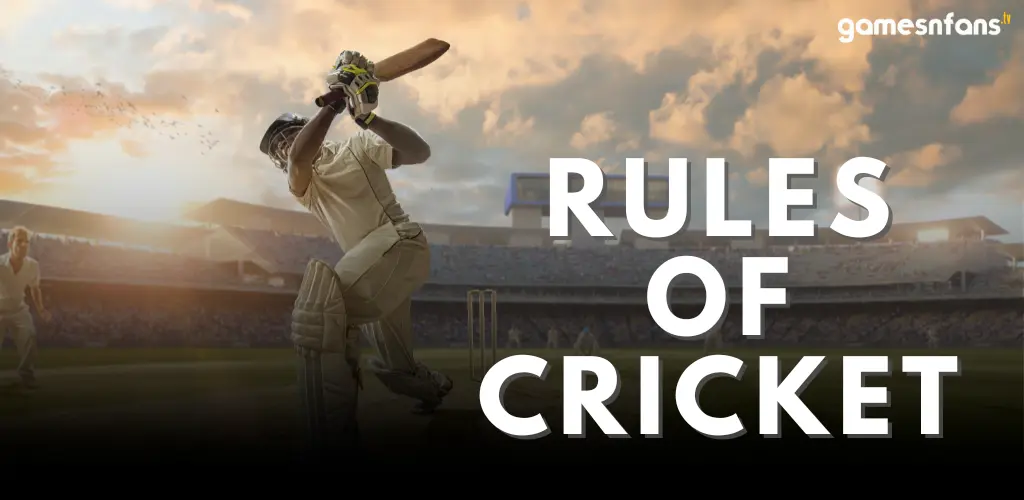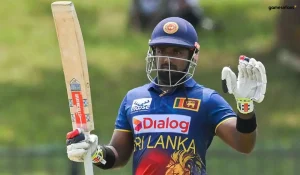Understanding the Rules of Cricket
9 min read
Every game on this planet has a specific set of rules that contribute to its overall appeal. These rules serve as guidelines for all participants, ensuring the smooth and fair progression of the game. While experienced cricket players and avid fans may find the basic rules intuitive and easy to comprehend, newcomers often struggle to grasp the intricacies of the game. Additionally, even seasoned cricket experts can become captivated by the more advanced rules, leading to occasional errors. It is worth noting that the rules of cricket are subject to periodic modifications to accommodate evolving gameplay.
We are here to provide you with assistance in navigating the ever-changing maze of cricket rules and guidelines. Whether you are a newcomer, a passionate cricket fan, or a professional player, there is something for everyone. Our comprehensive overview can be considered the Bible of cricket, equipping you with all the necessary knowledge to understand the game, outperform your friends with your expertise, showcase your love for the sport, or even pursue a professional career.
To facilitate easy comprehension for beginners, we are commencing with the fundamental principles that form the core of this game. If you are already familiar with the game, feel free to skip these principles. However, for beginners, they serve as essential key points for delving into the very essence of the game.
Fundamental Principles Of The Game Of Cricket
For any beginner, it is important to start by understanding the equipment and materials required for the game. In cricket, the materials needed to initiate play are relatively simple and consist of just four elements:
- A bat: A flat wooden stick with a handle.
- A spherical ball: A specific type of ball used in cricket.
- Three stumps: Wooden straight sticks measuring 28 inches in height.
- Two bails: Small wooden pieces placed on top of the stumps.
Foundation Of Cricket
Now, let’s dive into the composition of a cricket team. A cricket team consists of eleven players, encompassing batsmen, bowlers, and all-rounders. Batsmen excel in their batting abilities and typically take the lead when the team is at the crease. On the other hand, bowlers showcase their strength in their bowling capabilities and often deliver overs when the team is in the field. An all-rounder is a versatile player who possesses skills in both batting and bowling, contributing to the team’s performance in multiple facets of the game.The cricket match takes place in a ground, typically of circular or oval shape, where an inner circle with a radius of 30 yards exists and is covered with grass. In the centre of this circle lies a rough, soil-covered area 22 yards in length,known as the pitch. Adjacent to the pitch, wickets are firmly set into the ground. Two batsmen stand on opposite sides of the pitch, ready to face the bowler who initiates the bowling from one end. Positioned behind the wickets, a wicketkeeper awaits to collect the ball after it is bowled.
Metrices
The ground is covered with a boundary line which indicates the end line of the playing area.
Players other than the bowler and wicket keeper of the bowling team stand in the remaining field they are known as fielders.
The ground is covered with a boundary line which indicates the end line of the playing area.
Once the bowler delivers the ball, the batsman uses the bat in hand to strike it on the ground, aiming to send it towards the boundary line. The batsman’s objective is to score runs for the batting team. Meanwhile, fielders from the bowling team actively try to prevent the ball from crossing the boundary by fielding it and returning it to either the bowler or the wicketkeeper. Their efforts aim to limit the number of runs scored by the batting team and potentially dismiss the batsman by getting them out.
Read More: IPL 2024: Full List Of Unavailable And Injured Players
Basic Concept Of Cricket
● Run: A run is the smallest unit of scoring in cricket. When a batsman hits the ball and runs from one end of the pitch to the other, their team is awarded one run. The more runs a team accumulates, the higher their score.
● Four: When the ball, after being struck by the batsman’s bat, crosses the boundary line after hitting the ground at least once, four runs are added to the batting team’s score.
● Six: If the ball, following contact with the batsman’s bat, clears the boundary line without touching the ground, six runs are added to the batting team’s score.
● Out: The bowler aims to dismiss the batsman by taking their wicket. When a batsman is out, they must leave the field and return to the dressing room. The next player in the batting order then comes in to bat. The bowling team needs to take ten dismissals to fully complete the batting side. There are various ways a batsman can be dismissed, which we will explore later in this blog.
●Over: An over consists of six deliveries (or balls) bowled consecutively by a single bowler. Once the bowler has delivered six balls, their over is considered complete, and it is then time for another bowler to take their turn and bowl their set of six balls.

Now that you have familiarised yourself with the basic principles of cricket, you are ready to delve into the more intricate and nuanced rules of the game.
By delving into these more complex rules and strategies, you will gain a deeper understanding of the game and develop an appreciation for the strategic battles that unfold on the cricket field.
Penalties
The rules for the game of cricket are designed to ensure fair play and maintain the spirit of the sport.
“In cricket, just like in any other domain, breaking the rules comes with consequences. The fundamental principle of cause and effect applies, meaning that every illegitimate delivery by a bowler warrants an appropriate penalty. With that in mind, here is a list of such penalties: The rules for the game of cricket are designed to ensure fair play and maintain the spirit of the sport.
No Ball
“A ‘No Ball’ is an illegitimate delivery bowled by the bowler, often unintentionally. It can occur due to various causes, resulting in a delivery that does not conform to the rules of the game.
There are several ways in which a bowler can bowl a no ball, including overstepping the popping crease, having their back foot touching or going behind the return crease, or bowling an above-waist full toss without the batsman having played a shot.
Read More: Learn About Types of Bowling in Cricket
These instances lead to the delivery being deemed invalid and penalised as a no ball. When a no ball is bowled, the batting team benefits from it, usually in the form of an additional run added to their score. Sometimes a free hit is also given to the batting team in which the batsman can’t be dismissed even if he gets out.
Wide Ball
A “Wide Ball” is a delivery bowled by the bowler that is deemed too wide for the batsman to reach comfortably. It is called by the umpire when the ball is bowled outside the prescribed area for a fair delivery. The main criterion for judging a wide ball is whether the ball is within the reach of the batsman without them having to move their feet significantly.
The penalty for a wide ball results in an extra run for the batting team.
Dead Ball
A “Dead Ball” is a situation in cricket that occurs when the ball bounces twice or more before reaching the batsman’s crease. This results in the ball being deemed invalid and the play being halted momentarily..
Ways Of Dismissals
Familiarising yourself with the rules of a cricket game is crucial before participating in any cricketing event. Cricket rules of the game outline the procedures, boundaries, and guidelines that teams must adhere to during play.
When the batsman strikes the ball and it is caught by any of the 11 players from the opposing team without the ball touching the ground, the batsman is dismissed by way of a catch. This mode of dismissal is considered one of the most skillful and exciting ways to dismiss a batsman in cricket.
Bowled
When the bowler delivers the ball and it hits the stumps directly, causing the bails to be dislodged, the batsman is dismissed by way of being “bowled.” This mode of dismissal occurs when the ball strikes the stumps without any intervention from the batsman’s bat or body. It is considered a clean and decisive method of getting the batsman out.
Run Out
A batsman can be dismissed due to a run out when, while attempting to complete a run, they fail to reach the crease within the field of play before a fielder dislodges the bails by hitting the stumps with the ball. In this scenario, the fielding team successfully prevents the batsman from completing the run by accurately hitting the stumps. The umpire then declares the batsman as “run out” and they are dismissed from the field.
Stumped
When a batsman, while attempting to play a shot, moves out of their crease and fails to return to the crease before the wicketkeeper removes the bails with the ball, the batsman is dismissed by way of a stumping. The wicketkeeper plays a crucial role in this mode of dismissal by swiftly gathering the ball and breaking the wicket before the batsman can ground any part of their body or bat behind the crease.

LBW ( Leg Before Wicket)
LBW (Leg Before Wicket) is a mode of dismissal in cricket where the umpire rules the batsman out if the ball, before striking the bat, hits the batsman’s leg and would have struck the stumps after that.
Hit Wicket
Sometimes, during their batting, batsmen unintentionally hit the stumps with their bat or any part of their body, resulting in their dismissal. This mode of dismissal is known as being “hit wicket.”
Timed Out
Timed Out” is a lesser-known mode of dismissal in cricket, mainly because it occurs very rarely, sometimes only once or twice in a century. This form of dismissal occurs when the incoming batsman fails to reach the crease within a specific time after the previous batsman has been dismissed. The batsman is expected to be ready and on the field promptly to continue the game. If they do not make it within the allocated time, the umpire declares them “Timed Out,” resulting in their dismissal without even facing a ball.
Retired Out
In cricket, if a batsman voluntarily decides to retire from the ground due to reasons such as fatigue, cramps, or injury, they can be declared “Retired Out.” This mode of dismissal is initiated by the batsman themselves, indicating their intention to no longer participate in the innings. Once the batsman retires, they cannot return to bat in the same innings.
Obstructing The Field
When a batsman intentionally interferes in the fielding attempt of any fielder then he can be given out for obstructing the field.
Handling The Ball
Handling the Ball is a rare mode of dismissal in cricket that occurs when a batsman deliberately touches the ball with their hand or any part of their arm without the permission of the fielding side. This form of dismissal is considered against the spirit of the game as it goes against the principle of fair play.
A – MCC is a private club which was formerly cricket’s official governing body, a role now fulfilled by the International Cricket Council (ICC). MCC retains copyright in the Laws and only the MCC may change the Laws, although usually this is only done after close consultation with the ICC and other interested parties such as the Association of Cricket Umpires and Scorers.
A- The powerplay in cricket holds significant importance and has a considerable impact on the dynamics of the game. Here are a few reasons why power plays are crucial:
Fielding Restrictions ,Accelerating the Run Rate, Setting a Platform, Momentum Shift






